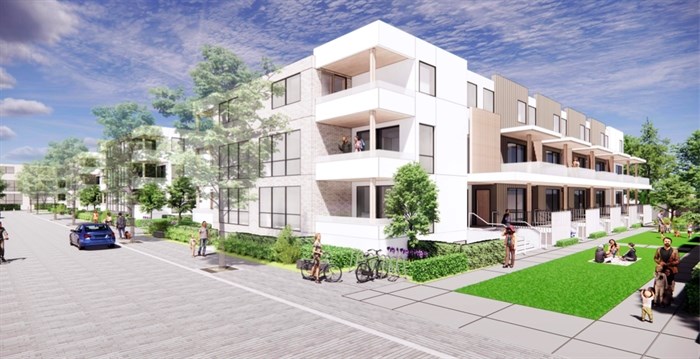How a $500 tax break gets rental housing built in Kelowna

It doesn’t seem like a lot on a multi-million dollar project but $500 per unit can make or break major rental building construction in Kelowna.
Take Westcorp’s 1,000-plus Ledge on Lakeshore rental project as an example.
The latest phase with 128 townhouse units received a $58,475 tax break from the City of Kelowna earlier this week that applies for each of the next 10 years, just because the developer is building rental units. That works out to about $457 per unit.
“Especially in this particular economic climate, with construction pricing and interest rates as high as they are, this was a very important aspect of what we needed approved for Ledge on Lakeshore for sure,” Westcorp vice-president Gail Temple told iNFOnews.ca. “That’s a real help to the operational side of the business.
“You need to be charging enough rent to cover off the taxes and operations of the building. Taxes, as we all know, they’ve really risen in the past decade.
"The amount of increase in operating expenses on rental units has just skyrocketed in the last five years, due to interest carrying costs, of course, but insurance has just gone sky high on so many projects. It’s just become a very very difficult part of the operating costs of any project.
“Probably, over the last five years, operating costs have seen increases in the range of 25-30% and, in that same period of time – let’s not forget we had COVID in there too but, even after COVID where you had no rental increases at all – I don’t think you’ve seen more than a 5% increase in the ability to raise rents.”
That doesn’t mean Westcorp pays no taxes on its massive development.
For 10 years they don't pay the difference between what the property was valued at before construction (it used to be a trailer park and campground) and the added value of the new apartment buildings.
READ MORE: Kamloops and Kelowna housing starts lagged behind rest of BC in 2023
Since the City of Kelowna offers this tax break, that means Westcorp also qualifies under provincial rules to be exempt from school taxes.
Canada Mortgage and Housing Corporation offers lower borrowing rates for rental construction and the federal government recently made building materials for rentals exempt from the GST.
“(Developers) start to layer these things together,” James Moore, the City of Kelowna’s infill and housing policy manager, told iNFOnews.ca. “What we’ve heard from the industry is that the grants are very, very important for rental projects. They become a powerful tool that lets them actually take a project that otherwise might not have made it and bring it to market and provide much needed housing.”
The tax exemption program was launched in 2012, but for the first few years there was little interest in it because no one was building rental housing in Kelowna. That changed around a few years ago when the market shifted.
“The number of permits we have issued and the number of projects we have under construction, we are on target for meeting our rental housing needs in the next few years,” Moore said. “I’m very optimistic that given the amount of brand-new purpose-built rental housing that we have under construction today, we will start to see some improvement in the rental market in the next one to two year period.”
A vacancy rate of 3% is considered a healthy rental market and Kelowna hasn't had a rental vacancy rate of less than 3% since 2012.
That may change in the next couple of years.
There's a lag of at least a year between when new rental housing is completed and when CHMC includes it in its vacancy data because it waits a year after completion to allow projects time to fill up.
“The challenge we’re having right now is a lot of the units are under construction and it takes some time to build these buildings,” Moore said. “They’re sometimes part of large complexes and getting them to occupancy is taking longer than we anticipated.”
The tax exemption is just one of the pieces that make rental construction possible.
“There’s all sorts of things that have to be right in order to move ahead with a rental project,” Temple with Westcorp said. “A lot of people have been doing that now just because sales have slowed and construction costs are so incredibly high. One of the challenges you have when you’re doing a for-sale project is, you’re trying to sell at a certain time with pre-sales, yet construction pricing might continue to move over the next few years.
“That gets some developers into trouble. It has historically and it will continue to. Rental is one of the things people have turned to because at least they can establish their rents once the project is finished.”
Of course, those rents have to be set high enough initially to offset provincial caps on annual rent increases. That cap is 3.5% this year but has been in the 2% range for the past couple of years.
Ledge on Lakeshore is for higher-end renters with its large two- and three-bedroom units with nice finishes, Temple said. With some smaller suites planned for the three towers yet to be built (a 12-storey building will be next then two more at 17 storeys each) that will allow for a diverse range of rental options.
“The tax exemption is not about affordability,” Moore said. “There is no direct connection to affordability. The connection to affordability is indirect where, if you don’t have units being built and the demand is there, your housing crisis is going to be a lot worse.”
READ MORE: Average rent in Kelowna declined in 2023 but still very expensive
On the affordable side, the city has a $300,000 per year Rental Housing Grants program for below-market rentals, usually built by non-profits or BC Housing, with rents being no more than 30% of income.
Only one, for a 20-storey BC Housing highrise on Bertram Street, was applied for and granted this year.
That program used to be open to any rental project but has now been targeted to below-market projects. They also qualify for the tax break.
The city’s housing needs study says that 25% of new housing construction over the next 20 years needs to be affordable. An update is just beginning on the city’s plan on how to get there – with a target of this summer for getting that done – and a review of the amount of money in that program will be part of that update, Moore said.
The difference between the two programs is that one is a tax exemption while the below-market rent program is a grant from tax dollars. That means it will be up to city council to decide if it will be increased in the future.
“Rental housing is real bright spot in our community right now for the housing story,” Moore said. “We’ve got a lot of stock under construction. We’ve got a lot of stock in stream. If we can keep that stock in stream going into construction, we’re going to be in a much improved position in a few years. That, again, loops right back to the beginning: what are the municipal tools that we can leverage to keep projects that are in steam all the way to making the decision to say: ‘Yes, let’s build.”
To contact a reporter for this story, email Rob Munro or call 250-808-0143 or email the editor. You can also submit photos, videos or news tips to the newsroom and be entered to win a monthly prize draw.
We welcome your comments and opinions on our stories but play nice. We won't censor or delete comments unless they contain off-topic statements or links, unnecessary vulgarity, false facts, spam or obviously fake profiles. If you have any concerns about what you see in comments, email the editor in the link above. SUBSCRIBE to our awesome newsletter here.



